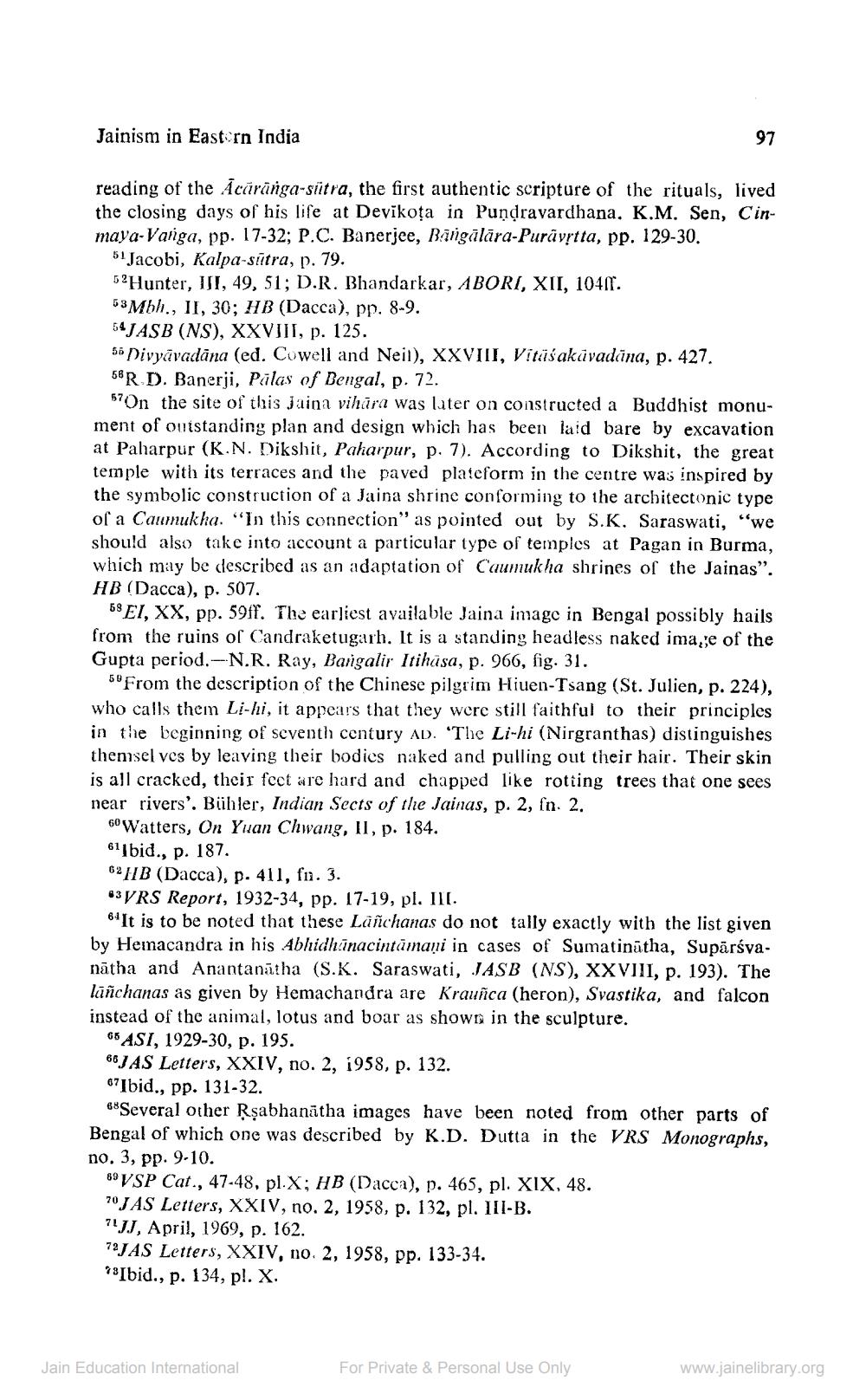________________
Jainism in Eastern India
reading of the Ācārānga-sutra, the first authentic scripture of the rituals, lived the closing days of his life at Devikota in Pundravardhana. K.M. Sen, Cinmaya-Varga, pp. 17-32; P.C. Banerjee, Bangālāra-Purāvrtta, pp. 129-30.
51 Jacobi, Kalpa-sutra, p. 79. 52 Hunter, III, 49, 51; D.R. Bhandarkar, ABORI, XII, 10411. 53Mbh., II, 30; HB (Dacca), pp. 8-9. 54 JASB (NS), XXVIII, p. 125. 56 Divyāvadāna (ed. Cowell and Neil), XXVIII, Vitiisakāvadāna, p. 427. 58R D. Banerji, Pilas of Bengal, p. 72.
570n the site of this Jaina vihāra was later on constructed a Buddhist monument of outstanding plan and design which has been laid bare by excavation at Paharpur (K.N. Dikshit, Paharpur, p. 7). According to Dikshit, the great temple with its terraces and the paved plateform in the centre was inspired by the symbolic construction of a Jaina shrine conforming to the architectonic type of a Caumukha. "In this connection" as pointed out by S.K. Saraswati, "we should also take into account a particular type of temples at Pagan in Burma, which may be described as an adaptation of Caumukha shrines of the Jainas”. HB (Dacca), p. 507.
58 E1, XX, pp. 59ff. The earliest available Jaina image in Bengal possibly hails from the ruins of Candraketugarh. It is a standing headless naked image of the Gupta period.-N.R. Ray, Bangalir Itihasa, p. 966, fig. 31.
50From the description of the Chinese pilgrim Hiuen-Tsang (St. Julien, p. 224), who calls them Li-hi, it appears that they were still faithful to their principles in the beginning of seventh century AD. 'The Li-hi (Nirgranthas) distinguishes themselves by leaving their bodies naked and pulling out their hair. Their skin is all cracked, their feet are hard and chapped like rotting trees that one sees near rivers'. Bühler, Indian Sects of the Jainas, p. 2, fn. 2.
GO Watters, On Yuan Chwang, II, p. 184. 611bid., p. 187. 62HIB (Dacca), p. 411, fu. 3. "3 VRS Report, 1932-34, pp. 17-19, pl. III.
6' It is to be noted that these Lañchanas do not tally exactly with the list given by Heinacandra in his Abhidhinacintamani in cases of Sumatinātha, Supārsvanātha and Anantanātha (S.K. Saraswati, JASB (NS), XXVIII, p. 193). The lāñchanas as given by Hemachandra are Krauñca (heron), Svastika, and falcon instead of the animal, lotus and boar as shown in the sculpture.
65ASI, 1929-30, p. 195. 66JAS Letters, XXIV, no. 2, 1958, p. 132. 67Ibid., pp. 131-32.
68Several other Rşabhanātha images have been noted from other parts of Bengal of which one was described by K.D. Dutta in the VRS Monographs, no. 3, pp. 9-10.
89VSP Cat., 47-48, pl.X; HB (Dacca), p. 465, pl. XIX, 48. 70 JAS Letters, XXIV, no. 2, 1958, p. 132, pl. III-B. ? JJ, April, 1969, p. 162. 72JAS Letters, XXIV, no. 2, 1958, pp. 133-34. 'Ibid., p. 134, p!. X.
Jain Education International
For Private & Personal Use Only
www.jainelibrary.org




